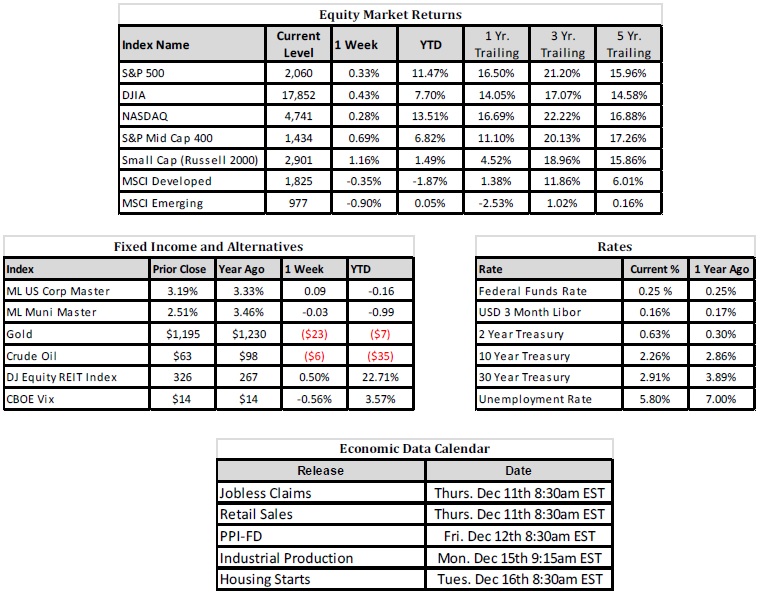
Capital Markets Update – Week of 12/8/2014
Market Overview
Sources: Rates Data and Economic Calendar—Bloomberg Markets as of 12/09/14; Equity Market Returns and Fixed Income and Alternatives Data—Wells Fargo Advisers as of 12/08/14.
Happening Now
Volatility Picks Up into Year End
After seven consecutive weekly gains for the S&P500 where the index increased over 10%, volatility is beginning to creep back into the US stock market. Over this same seven week time period the CBOE Volatility Index (VIX) decreased a staggering 47% but since Friday, has posted an 8.9% gain during Monday’s trading and opened Tuesday up an additional 14%. This sharp increase in volatility coincides with negative economic news coming out of Europe and Asia where a German Industrial reading was weaker than expected, Greece is facing political uncertainty and China raised standards for what type of bonds it will allow for use as collateral.
Historically, volatility has been more prevalent in the US Stock market. According to Reid Steadman of S&P Dow Jones Indices, the mean level of the VIX has been 17.1 or 24% higher than this year’s mean of 13.8. While some investors may now only associate an increase in the VIX with negative stock returns it should not be forgotten that it likely could be reverting to more normalized levels.
Heading into year end, US equity investors also begin to consider their tax harvesting opportunities where selling takes place to lock in short or long term losses than can be used to offset realized capital gains acquired throughout the year. This can put some downward pressure on stock prices in December and precedes the positive performance of stock prices during what is commonly known as the “January Effect.”
We pay attention to the short term movement in the equity markets in order to see if there is a larger trend taking place, but we remain focused on the underlying economic fundamentals that fuel long term sustainable equity market growth. So, while there may be selling and an increase in volatility into year-end we believe that it is more likely that some form of a Santa Clause Rally will take place and US stock prices will likely move slightly higher from their current levels.
Important Information and Disclaimers
Past Performance is not a guarantee of future performance.
Investing in foreign securities presents certain risks not associated with domestic investments, such as currency fluctuation, political and economic instability, and different accounting standards. This may result in greater share price volatility. These risks are heightened in emerging markets.
There are special risks associated with an investment in real estate, including credit risk, interest rate fluctuations and the impact of varied economic conditions. Distributions from REIT investments are taxed at the owner’s tax bracket.
The prices of small company and mid cap stocks are generally more volatile than large company stocks. They often involve higher risks because smaller companies may lack the management expertise, financial resources, product diversification and competitive strengths to endure adverse economic conditions.
Investing in commodities is not suitable for all investors. Exposure to the commodities markets may subject an investment to greater share price volatility than an investment in traditional equity or debt securities. Investments in commodities may be affected by changes in overall market movements, commodity index volatility, changes in interest rates or factors affecting a particular industry or commodity.
Products that invest in commodities may employ more complex strategies which may expose investors to additional risks.
Investing in fixed income securities involves certain risks such as market risk if sold prior to maturity and credit risk especially if investing in high yield bonds, which have lower ratings and are subject to greater volatility. All fixed income investments may be worth less than original cost upon redemption or maturity. Bond Prices fluctuate inversely to changes in interest rates. Therefore, a general rise in interest rates can result in the decline of the value of your investment.
Definitions
MSCI- EAFE: The Morgan Stanley Capital International Europe, Australasia and Far East Index, a free float-adjusted market capitalization index that is designed to measure developed-market equity performance, excluding the United States and Canada.
MSCI-Emerging Markets: The Morgan Stanley Capital International Emerging Market Index, is a free float-adjusted market capitalization index that is designed to measure the performance of global emerging markets of about 25 emerging economies.
Russell 3000: The Russell 3000 measures the performance of the 3000 largest US companies based on total market capitalization and represents about 98% of the investible US Equity market.
ML BOFA US Corp Mstr [Merill Lynch US Corporate Master]: The Merrill Lynch Corporate Master Market Index is a statistical composite tracking the performance of the entire US corporate bond market over time.
ML Muni Master [Merill Lynch US Corporate Master]: The Merrill Lynch Municipal Bond Master Index is a broad measure of the municipal fixed income market.
Investors cannot directly purchase any index.
LIBOR, London Interbank Offered Rate, is the rate of interest at which banks offer to lend money to one another in the wholesale money markets in London.
The Dow Jones Industrial Average is an unweighted index of 30 “blue-chip” industrial U.S. stocks.
The S&P Midcap 400 Index is a capitalization-weighted index measuring the performance of the mid-range sector of the U.S. stock market, and represents approximately 7% of the total market value of U.S. equities. Companies in the Index fall between S&P 500 Index and the S&P SmallCap 600 Index in size: between $1-4 billion.
DJ Equity REIT Index represents all publicly traded real estate investment trusts in the Dow Jones U.S. stock universe classified as Equity REITs according to the S&P Dow Jones Indices REIT Industry Classification Hierarchy. These companies are REITSs that primarily own and operate income-producing real estate.




